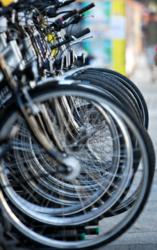
In 2011, the Office for National Statistics noted a 7% rise in reported cycle theft compared to the previous year; approximately 123,207 bicycles. The British Crime Survey, which also includes estimates of non-reported offences, puts the figure at 533,000. That's a lot of bikes.
Yannick Read of iLoveMyBike, one of cycleinsurance.co.uk's top providers, agreed that "most of the half million victims of cycle theft last year will have been uninsured, which is a blow both to the individual - who is left out of pocket - and cycling in general; research has shown that having a bike stolen leaves people reluctant to replace it and carry on cycling. Unfortunately, it’s a problem that looks set to get worse - as long as bikes are a cinch to steal and even easier to sell on afterwards, petty thieves will continue to pinch them. There are high-tech solutions on the horizon, including GPS trackers that can be hidden inside a bicycle’s frame, but it will be some time before such gizmos are common place so in the meantime cyclists are best advised to invest in a stout lock and a good insurance policy."
With current police estimates suggesting that only 5-8% of stolen cycles are ever re-united with their owners, the team at Cycle Insurance have put together these top tips for keeping your bicycle safe.
1. The Right Lock.
If you have spent money on a bicycle, you should always purchase a suitable lock to keep it secure. Cheap, thin locks present no barrier to a bicycle thief; they will simply cut through them and ride away in moments. You should seriously consider purchasing a Sold Secure rated lock based on the value of your cycle, usually it is suggested the lock should cost at least 10% of the cycle value. You should also consider using more than one lock, making sure you have two different types. D locks are often more reliable than chains or cables, as they are less easily cut.
All of this creates more work for the thief before they can free your cycle, and the harder it is to remove your bike the more likely they will be to leave it alone.
2. The Right Way.
Never secure the lock just through the wheels. If you do, the wheels may be the only thing you come back to. Always secure through the wheels and the frame, preferably at the front and the back of the cycle.
It is also recommended that you avoid securing your cycle to old fashioned Victorian iron railings. These can sometimes be broken with a sharp hammer blow, and the thief might just take the cycle, locks and railing with them!
3. The Right Place.
Lock your bike in a busy, public area. Thieves are less likely to strike when there are lots of people around to see them at work. Whenever possible, lock your bike indoors, and never leave it outside overnight if it can be avoided.
It’s also good to be aware of the local cycle theft hotspots in your area. Look at the crime map in your town and if you can see that certain locations suffer more thefts than others, avoid them! This won’t always work, but it is common sense and may help to reduce the risk of theft.
There are a few signs to look out for that might indicate that someone is trying to, or has tried to steal your bicycle.
If you come back to find one of your tyres punctured, you should immediately remove the bike and take it indoors. Thieves who desire a cycle will often deliberately puncture a tyre to stop the bike being ridden away, tempting the owner to leave in the rack. They will then go to collect the right tools to deal with the locks and come back later to steal the cycle at their leisure.
If using a combination lock, set it to a set number when leaving the bike. If it has changed when you return, someone may be trying random combinations on the off chance of getting it right.
We hope that these tips have been helpful. Remember, whatever security devices you use, there is still a chance that your cycle could be stolen by a determined thief. You should always consider purchasing Cycle Insurance to cover you if the worst should happen.
This press release is presented for your information only.
Full Disclosure Statement: The GREEN (LIVING) REVIEW received no compensation for any component of this article.
This article is for your information only and the GREEN (LIVING) REVIEW does not (necessarily) approve, endorse or recommend the product, service or company mentioned.























